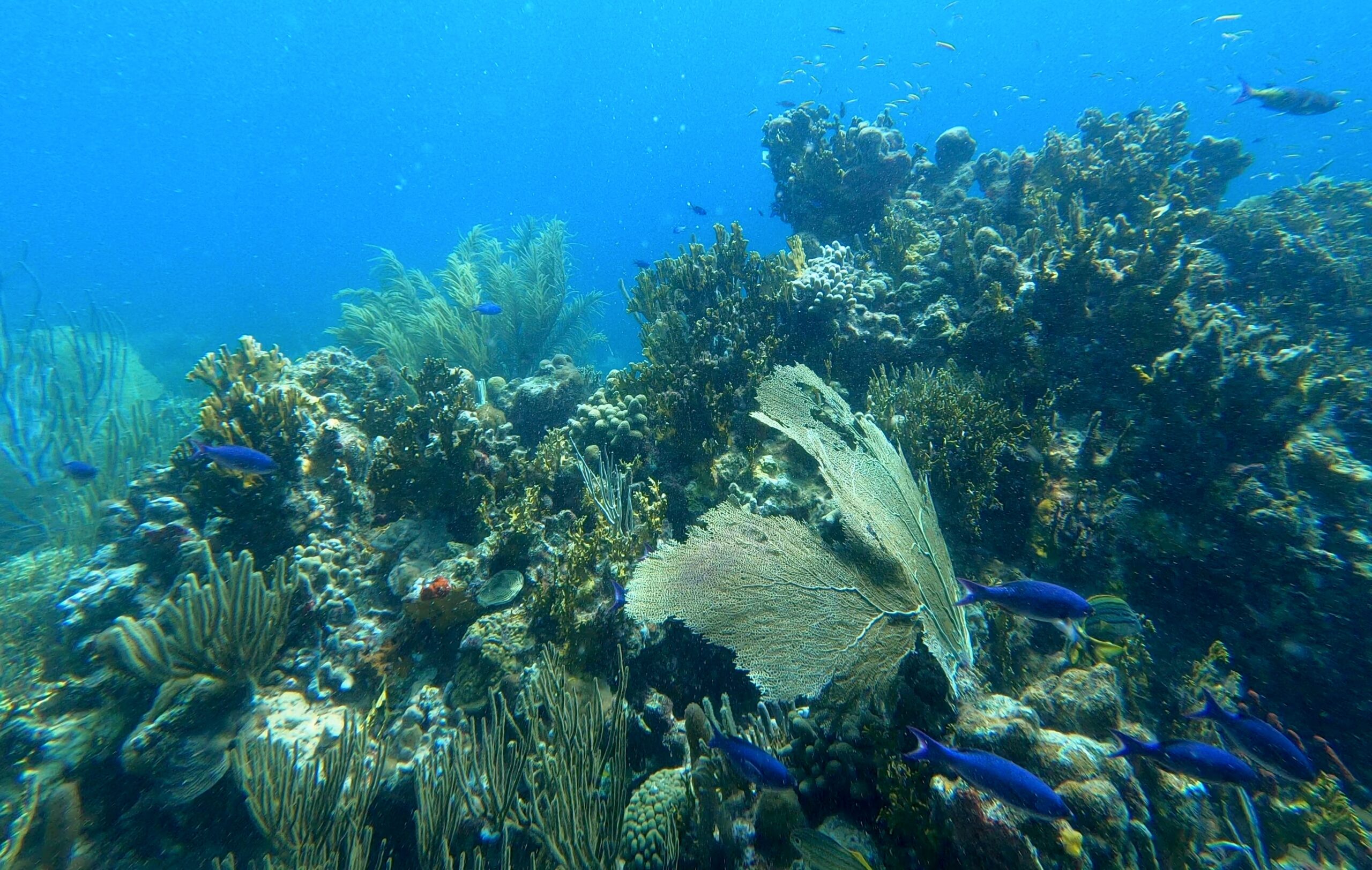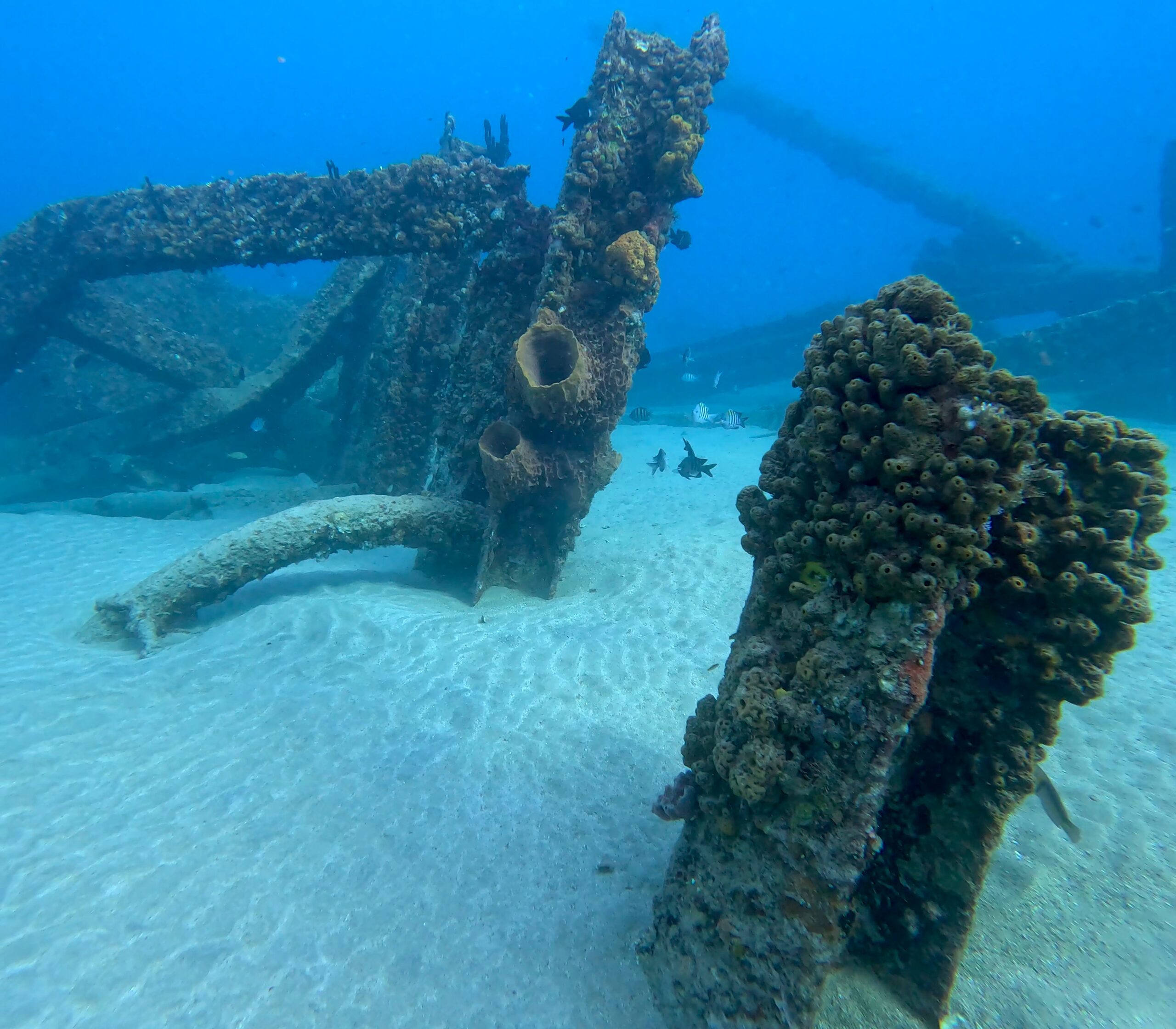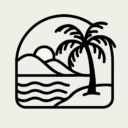Scuba Diving
Puerto Rico may not be known as a world-class diving destination, but it does have a handful of dives worth your time. I have not dived at every location but I have had some great scuba experiences and have friends that have as well. In general, reefs in the Caribbean are in rough shape. Soft coral is more abundant than hard coral. You will tend to see the same cast of tropical fish in most locations, though some dive sites are better than others when it comes to marine life. There are more dive locations than I have listed but these are the best.
Overview
Scuba diving at the wall has easily been one of my favorite underwater experiences in Puerto Rico. It is often considered the best scuba diving on the main island. We started off the dive with a bang: Caribbean Reef Sharks circled a bait box dropped in the water by the crew. One of the sharks followed us around for most of the dive and the divemaster apparently knows each local shark by sight. I have been afraid of sharks my whole life but when it came down to facing off with one just a body length away, I felt a surprising calm. The wall itself was colorful and impressive. There is a good amount of fish along the wall and before the drop-off with a higher-than-average species diversity. This is the must-do dive in Puerto Rico.
Getting There
Guánica is located on the southwestern coast of Puerto Rico. The dive site, The Wall, is accessible by boat, with local dive operators like Island Scuba. The boat ride is not too long but the swell can feel large once you’ve left the bay. I recommend motion sickness medication. Two out of four of us threw up during the safety stop, sitting on the boat for twenty minutes as it rocked with the swell. I managed my own motion sickness by staring at the coastline.
Dive Sites
1. Black Wall
– Depth: 60-120 feet (18-36 meters)
– Features: This section of The Wall is characterized by its dark, volcanic rock formations covered with corals and sponges. The steep drop-off and excellent visibility create a breathtaking diving experience, with sightings of large pelagic species like barracuda and eagle rays.
2. The Sand Slides
– Depth: 40-100 feet (12-30 meters)
– Features: Named for the sandy slopes that cascade down the wall, this site is home to vibrant coral gardens and diverse marine life. Divers can explore crevices and overhangs while spotting reef fish, sea turtles, and moray eels.
3. Cañones
– Depth: 70-130 feet (21-40 meters)
– Features: Cañones, or “The Cannons,” is known for its underwater canyons and swim-throughs. The site offers a sense of exploration and adventure, with abundant marine life, including lobsters, groupers, and occasionally, nurse sharks.

Overview
Vieques Island, located off the eastern coast of Puerto Rico, is famed primarily for its bioluminescent bay but it has decent scuba diving as well. The island’s diverse underwater landscapes and relatively abundant marine life make it a top Puerto Rico destination for divers of all skill levels. Vieques Island’s underwater world is rich with marine biodiversity. I have seen sea turtles, eagle rays, sting rays, barracuda, tarpon, a juvenile reef shark, angelfish, parrotfish, damselfish, and more.
Getting There
Vieques Island is accessible by ferry from Ceiba or by small plane from San Juan or Ceiba. Once on the island, Isla Nena Scuba o Black Beard Sports can take you to one of the many dive sites. Coordinate with them ahead of your arrival as their dive slots do fill. Black Beard’s is within walking distance of the ferry terminal.
Dive Sites
Muelle de Mosquitos
– Depth: 20-60 feet (6-18 meters)
– Features: This seems to be the most popular dive site on the island. The remnants of an old navy pier create an artificial reef teeming with marine life. The shallow depth and calm conditions make it ideal for beginners and snorkelers. Divers can explore the pier’s structure and encounter schools of fish, octopuses, and colorful corals.
2. Cayo Afuera
– Depth: 30-70 feet (9-21 meters)
– Features: This site offers a mix of coral gardens, sandy bottoms, and rocky outcrops. It is home to a diverse range of marine species, including parrotfish, angelfish, and sea turtles. The site is suitable for all skill levels and provides excellent opportunities for underwater photography.
3. Esperanza Reef
– Depth: 20-50 feet (6-15 meters)
– Features: Located near the town of Esperanza, this reef is known for its vibrant coral formations and abundant marine life. Divers can spot barracuda, stingrays, and a variety of reef fish. The reef’s shallow depth makes it perfect for novice divers and snorkelers.
Culebra

Overview
Culebra Island, a small gem in the Spanish Virgin Islands, offers some of the best scuba diving in the Caribbean. Known for its pristine beaches, clear turquoise waters, and thriving coral reefs, Culebra is a paradise for divers. With a variety of dive sites suitable for all skill levels, Culebra Island provides an unforgettable underwater adventure.
Getting There
Culebra Island is accessible by ferry or small plane from mainland Puerto Rico. Ferries depart from Ceiba, while flights are available from San Juan and Ceiba. Once on the island, local dive shops and tour operators offer guided dive trips, equipment rentals, and courses, ensuring a seamless diving experience. Culebra Divers
Dive Sites
Culebra Island boasts numerous dive sites, each offering unique underwater landscapes and marine life:
1. Carlos Rosario Reef
– Depth: 20-60 feet (6-18 meters)
– Features: This shallow reef is perfect for beginner divers and snorkelers. It features vibrant coral gardens and a variety of tropical fish, such as parrotfish, angelfish, and sergeant majors. The calm waters and excellent visibility make it an ideal spot for underwater photography.
2. Tamarindo Reef
– Depth: 20-50 feet (6-15 meters)
– Features: Tamarindo Reef offers a mix of coral formations and seagrass beds, providing a habitat for diverse marine life. Divers can spot sea turtles, stingrays, and various species of reef fish. The site is suitable for all skill levels.
3. The Wall
– Depth: 40-90 feet (12-27 meters)
– Features: A dramatic underwater wall covered in corals and sponges, this site is a favorite for intermediate and advanced divers. The wall attracts larger pelagic species, including barracuda, eagle rays, and the occasional reef shark.
Overview
Fajardo, located on the eastern coast of Puerto Rico, is the gateway to other smaller islands located off the east coast of the main island. Among these, Palomino Island and Devil’s Cay are popular dive sites. You’ll see a lot of different soft corals, reef fish, and likely sea turtles. Dolphins are somewhat common in this area but I was never lucky enough to see any. I ate a good yucafongo at Cinco Nudos after getting back to the marina with a couple friends and a guy we met on the dive.
Getting There
Palomino Island and Devil’s Cay are accessible by boat from Fajardo. I went with Sea Ventures for a guided dive trip to these sites. Park in the marina aquí. The boat ride typically takes about 20 minutes to the first location – Palomino Island. The boat ride from there to Devil’s Key takes another 20-30 minutes.
Dive Sites
Isla Palomino
1. Palomino Reef
– Depth: 20-60 feet (6-18 meters)
– Features: This site boasts extensive coral gardens teeming with tropical fish. The shallow depth and calm conditions make it ideal for beginner divers and snorkelers. Expect to see angelfish, parrotfish, and butterflyfish.
2. The Drop
– Depth: 40-80 feet (12-24 meters)
– Features: A sloping reef that leads to a deeper drop-off, this site offers stunning coral formations and abundant marine life. Intermediate divers will enjoy exploring the crevices and overhangs, home to lobsters, moray eels, and barracuda.
3. Palomino Wall
– Depth: 60-100 feet (18-30 meters)
– Features: This impressive wall dive features vertical coral formations and excellent visibility. Advanced divers can enjoy sightings of larger pelagic species, such as reef sharks, eagle rays, and schools of jacks.
Devil’s Cay
1. Devil’s Reef
– Depth: 30-70 feet (9-21 meters)
– Features: Known for its vibrant coral and sponge-covered structures, Devil’s Reef is home to a rich diversity of marine life. Divers can spot sea turtles, stingrays, and a variety of reef fish, including snappers and groupers.
2. The Caves
– Depth: 50-90 feet (15-27 meters)
– Features: This site offers an exciting underwater adventure with its network of swim-throughs and caves. Advanced divers will enjoy exploring these structures while encountering schools of fish, octopuses, and the occasional nurse shark.
3. The Pinnacle
– Depth: 40-100 feet (12-30 meters)
– Features: A towering underwater pinnacle adorned with corals and sponges, this site is a haven for marine life. Divers can expect to see colorful reef fish, crustaceans, and larger species like barracuda and reef sharks.

Overview
Crash Boat Beach, located in Aguadilla on Puerto Rico’s northwest coast, is a vibrant and popular spot known for its beautiful sandy beaches and exceptional scuba diving opportunities. The beach’s clear turquoise waters, diverse marine life, and unique underwater structures make it a must-visit destination for divers of all experience levels.
Getting There
Crash Boat Beach is the most accessible dive spot on the list. It’s a popular shore dive location that frequently has great visibility and calm waters. Just park in the large (but often crowded) parking lot in front of the playa. Several local dive shops and tour operators offer guided dives and equipment rentals but it’s common to see local enthusiasts doing their own thing here.
Dive Sites
1. The Pier
– Depth: 10-40 feet (3-12 meters)
– Features: The remnants of an old military pier create an artificial reef teeming with marine life. The shallow depths and calm conditions make it an excellent spot for beginner divers and snorkelers. Expect to see colorful corals, sponges, and schools of tropical fish.
2. The Wrecks
– Depth: 20-50 feet (6-15 meters)
– Features: Several small shipwrecks lie near the pier, offering intriguing exploration opportunities. The wrecks are encrusted with corals and sponges, attracting diverse marine life, including snappers, groupers, and the occasional sea turtle.
3. The Wall
– Depth: 40-70 feet (12-21 meters)
– Features: A short swim from the pier, The Wall offers a dramatic drop-off with vibrant coral formations and abundant marine species. The site is perfect for intermediate divers, with sightings of barracuda, moray eels, and stingrays.

Overview
Desecheo Island, an uninhabited nature reserve located off the west coast of Puerto Rico, is a premier Caribbean destination for scuba diving enthusiasts. Desecheo boasts crystal-clear waters with 100 ft visibility and colorful coral reefs. Divers can even borrow a sling from the crew to spear lionfish they see.
Getting There
Desecheo Island lies 13 miles off the west coast of Puerto Rico and is accessible by boat from various towns like Rincón, Aguadilla, and Mayagüez. The only dive company that offers day trips to the island is Taino Divers, as far as I know. They depart out of Rincón at 8:00am and return at 2:00 pm, weather permitting. It is best to attempt this dive spot in the summer when the swell is smaller. Taino Divers will not hesitate to cancel a trip if the waves are too rough.
Dive Sites
1. Candyland
– Depth: 30-60 feet (9-18 meters)
– Features: Known for its vibrant coral formations and colorful sponges, Candyland is a shallow dive site perfect for beginners. The area is teeming with tropical fish, such as parrotfish, angelfish, and butterflyfish.
2. Las Cuevas
– Depth: 40-70 feet (12-21 meters)
– Features: Las Cuevas, or “The Caves,” offers a more adventurous dive with swim-throughs and overhangs. Divers can explore the intricate cave systems while encountering schools of jacks, groupers, and the occasional nurse shark.
3. The Arch
– Depth: 60-100 feet (18-30 meters)
– Features: A stunning natural arch formation covered in corals and sponges, this site is ideal for intermediate to advanced divers. The arch serves as a haven for larger pelagic species, including barracuda and reef sharks.
